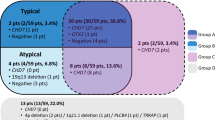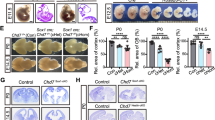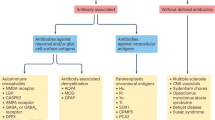Abstract
CHARGE syndrome is caused by a dominant variant in the CHD7 gene. Multiple organ systems can be affected because of haploinsufficiency of CHD7 during embryonic development. CHARGE syndrome shares many clinical features with the 22q11.2 deletion syndrome. Immunological abnormalities have been described, but are generally given little attention in studies on CHARGE syndrome. However, structured information on immunological abnormalities in CHARGE patients is necessary to develop optimal guidelines for diagnosis, treatment and follow-up in these patients. Here, we provide an overview of the current literature on immunological abnormalities in CHARGE syndrome. We also explore immunological abnormalities in comparable multiple congenital anomaly syndromes to identify common immunological phenotypes and genetic pathways that might regulate the immune system. Finally, we aim to identify gaps in our knowledge on the immunological aspects in CHARGE syndrome that need further study.
Similar content being viewed by others
Log in or create a free account to read this content
Gain free access to this article, as well as selected content from this journal and more on nature.com
or
References
Angelman H : Syndrome of coloboma with multiple congenital abnormalities in infancy. Br Med J 1961; 1: 1212–1214.
Edwards JH, Finlay HVL, Young RB : Coloboma with Multiple Congenital Anomalies. Br Med J 1961; 2: 586–587.
Hall BD : Choanal atresia and associated multiple anomalies. J Pediatr 1979; 95: 395–398.
Hittner HM, Hirsch NJ, Kreh GM, Rudolph AJ : Colobomatous microphthalmia, heart disease, hearing loss, and mental retardation—a syndrome. J Pediatr Ophthalmol Strabismus 1979; 16: 122–128.
Pagon RA, Graham JM Jr, Zonana J, Yong SL : Coloboma, congenital heart disease, and choanal atresia with multiple anomalies: CHARGE association. J Pediatr 1981; 99: 223–227.
Janssen N, Bergman JE, Swertz MA et al: Mutation update on the CHD7 gene involved in CHARGE syndrome. Hum Mutat 2012; 33: 1149–1160.
Blake KD, Davenport SL, Hall BD et al: CHARGE association: an update and review for the primary pediatrician. Clin Pediatr (Phila) 1998; 37: 159–173.
Verloes A : Updated diagnostic criteria for CHARGE syndrome: a proposal. Am J Med Genet A 2005; 133: 306–308.
Jongmans MC, Admiraal RJ, van der Donk KP et al: CHARGE syndrome: the phenotypic spectrum of mutations in the CHD7 gene. J Med Genet 2006; 43: 306–314.
Lalani SR, Safiullah AM, Fernbach SD et al: Spectrum of CHD7 mutations in 110 individuals with CHARGE syndrome and genotype-phenotype correlation. Am J Hum Genet 2006; 78: 303–314.
Vissers LE, van Ravenswaaij CM, Admiraal R et al: Mutations in a new member of the chromodomain gene family cause CHARGE syndrome. Nat Genet 2004; 36: 955–957.
Bergman JE, Janssen N, van der Sloot AM et al: A novel classification system to predict the pathogenic effects of CHD7 missense variants in CHARGE syndrome. Hum Mutat 2012; 33: 1251–1260.
Bergman JE, Janssen N, Hoefsloot LH, Jongmans MC, Hofstra RM, van Ravenswaaij-Arts CM : CHD7 mutations and CHARGE syndrome: the clinical implications of an expanding phenotype. J Med Genet 2011; 48: 334–342.
Jyonouchi S, McDonald-Mcginn DM, Bale S, Zackai EH, Sullivan KE : CHARGE (coloboma, heart defect, atresia choanae, retarded growth and development, genital hypoplasia, ear anomalies/deafness) syndrome and chromosome 22q11.2 deletion syndrome: a comparison of immunologic and nonimmunologic phenotypic features. Pediatrics 2009; 123: e871–e877.
Comans-Bitter WM, de Groot R, van den Beemd R et al: Immunophenotyping of blood lymphocytes in childhood. Reference values for lymphocyte subpopulations. J Pediatr 1997; 130: 388–393.
North KN, Wu BL, Cao BN, Whiteman DA, Korf BR : CHARGE association in a child with de novo inverted duplication (14)(q22—>q24.3). Am J Med Genet 1995; 57: 610–614.
Theodoropoulos DS : Immune deficiency in CHARGE association. Clin Med Res 2003; 1: 43–48.
Kaliakatsos M, Giannakopoulos A, Fryssira H et al: Combined microdeletions and CHD7 mutation causing severe CHARGE/DiGeorge syndrome: clinical presentation and molecular investigation by array-CGH. J Hum Genet 2010; 55: 761–763.
Lonlay-Debeney P, Cormier-Daire V, Amiel J et al: Features of DiGeorge syndrome and CHARGE association in five patients. J Med Genet 1997; 34: 986–989.
Markert ML, Alexieff MJ, Li J et al: Postnatal thymus transplantation with immunosuppression as treatment for DiGeorge syndrome. Blood 2004; 104: 2574–2581.
Markert ML, Alexieff MJ, Li J et al: Complete DiGeorge syndrome: development of rash, lymphadenopathy, and oligoclonal T cells in 5 cases. J Allergy Clin Immunol 2004; 113: 734–741.
Janda A, Sedlacek P, Mejstrikova E et al: Unrelated partially matched lymphocyte infusions in a patient with complete DiGeorge/CHARGE syndrome. Pediatr Transplant 2007; 11: 441–447.
Gennery AR, Slatter MA, Rice J et al: Mutations in CHD7 in patients with CHARGE syndrome cause T-B+natural killer cell+severe combined immune deficiency and may cause Omenn-like syndrome. Clin Exp Immunol 2008; 153: 75–80.
Boudny P, Kurrer MO, Stamm B, Laeng RH : Malakoplakia of the colon in an infant with severe combined immunodeficiency (SCID) and charge association. Pathol Res Pract 2000; 196: 577–582.
Wood DJ, David TJ, Chrystie IL, Totterdell B : Chronic enteric virus infection in two T-cell immunodeficient children. J Med Virol 1988; 24: 435–444.
Markert ML, Boeck A, Hale LP et al: Transplantation of thymus tissue in complete DiGeorge syndrome. N Engl J Med 1999; 341: 1180–1189.
Markert ML, Sarzotti M, Ozaki DA et al: Thymus transplantation in complete DiGeorge syndrome: immunologic and safety evaluations in 12 patients. Blood 2003; 102: 1121–1130.
Rice HE, Skinner MA, Mahaffey SM et al: Thymic transplantation for complete DiGeorge syndrome: medical and surgical considerations. J Pediatr Surg 2004; 39: 1607–1615.
Writzl K, Cale CM, Pierce CM, Wilson LC, Hennekam RC : Immunological abnormalities in CHARGE syndrome. Eur J Med Genet 2007; 50: 338–345.
Sanka M, Tangsinmankong N, Loscalzo M, Sleasman JW, Dorsey MJ : Complete DiGeorge syndrome associated with CHD7 mutation. J Allergy Clin Immunol 2007; 120: 952–954.
Hoover-Fong J, Savage WJ, Lisi E et al: Congenital T cell deficiency in a patient with CHARGE syndrome. J Pediatr 2009; 154: 140–142.
Chopra C, Baretto R, Duddridge M, Browning MJ : T-cell immunodeficiency in CHARGE syndrome. Acta Paediatr 2008; 98: 408–412.
Inoue H, Takada H, Kusuda T et al: Successful cord blood transplantation for a CHARGE syndrome with CHD7 mutation showing DiGeorge sequence including hypoparathyroidism. Eur J Pediatr 2010; 169: 839–844.
Assing K, Nielsen C, Kirchhoff M, Madsen HO, Ryder LP, Fisker N : CD4 CD31 recent thymic emigrants in CHD7 haploinsufficiency (CHARGE syndrome): A case. Hum Immunol 2013; 74: 1047–1050.
Markert ML, Majure M, Harville TO, Hulka G, Oldham K : Severe laryngomalacia and bronchomalacia in DiGeorge syndrome and CHARGE association. Pediatr Pulmonol 1997; 24: 364–369.
Markert ML, Hummell DS, Rosenblatt HM et al: Complete DiGeorge syndrome: persistence of profound immunodeficiency. J Pediatr 1998; 132: 15–21.
Squires LA, Dieffenbach AZ, Betz BW : Three malformation complexes related to neural crest development. Brain Dev 1998; 20: 183–185.
Lee KD, Okazaki T, Kato Y, Lane GJ, Yamataka A : Esophageal atresia and tracheo-esophageal fistula associated with coarctation of the aorta, CHARGE association, and DiGeorge syndrome: a case report and literature review. Pediatr Surg Int 2008; 24: 1153–1156.
Corsten-Janssen N, Saitta SC, Hoefsloot LH et al: More clinical overlap between 22q11.2 deletion syndrome and CHARGE syndrome than often anticipated. Mol Syndromol 2012; 4: 235–245.
Gennery AR : Immunological aspects of 22q11.2 deletion syndrome. Cell Mol Life Sci 2012; 69: 17–27.
McDonald-McGinn DM, Sullivan KE : Chromosome 22q11.2 deletion syndrome (DiGeorge syndrome/velocardiofacial syndrome). Medicine (Baltimore) 2011; 90: 1–18.
Finocchi A, Di Cesare S, Romiti ML et al: Humoral immune responses and CD27+ B cells in children with DiGeorge syndrome (22q11.2 deletion syndrome). Pediatr Allergy Immunol 2006; 17: 382–388.
Gennery AR, Barge D, O'Sullivan JJ, Flood TJ, Abinun M, Cant AJ : Antibody deficiency and autoimmunity in 22q11.2 deletion syndrome. Arch Dis Child 2002; 86: 422–425.
Patel K, Akhter J, Kobrynski L et al: Immunoglobulin deficiencies: the B-lymphocyte side of DiGeorge Syndrome. J Pediatr 2012; 161: 950–953.
Björk AH, Oskarsdottir S, Andersson BA, Friman V : Antibody deficiency in adults with 22q11.2 deletion syndrome. Am J Med Genet A 2012; 158A: 1934–1940.
Jawad AF, McDonald-Mcginn DM, Zackai E, Sullivan KE : Immunologic features of chromosome 22q11.2 deletion syndrome (DiGeorge syndrome/velocardiofacial syndrome). J Pediatr 2001; 139: 715–723.
McLean-Tooke A, Spickett GP, Gennery AR : Immunodeficiency and autoimmunity in 22q11.2 deletion syndrome. Scand J Immunol 2007; 66: 1–7.
Quiros-Tejeira RE, Ament ME, Heyman MB et al: Variable morbidity in alagille syndrome: a review of 43 cases. J Pediatr Gastroenterol Nutr 1999; 29: 431–437.
Le Friec G, Sheppard D, Whiteman P et al: The CD46-Jagged1 interaction is critical for human TH1 immunity. Nat Immunol 2012; 13: 1213–1221.
Scheuerle AE, Good RA, Habal MB : Involvement of the thymus and cellular immune system in craniofacial malformation syndromes. J Craniofac Surg 1990; 1: 88–90.
Niikawa N, Kuroki Y, Kajii T et al: Kabuki make-up (Niikawa-Kuroki) syndrome: a study of 62 patients. Am J Med Genet 1988; 31: 565–589.
Schulz Y, Freese L, Manz J et al: CHARGE and Kabuki syndromes: A phenotypic and molecular link. Hum Mol Genet 2014; 23: 4396–4405.
Hoffman JD, Ciprero KL, Sullivan KE et al: Immune abnormalities are a frequent manifestation of Kabuki syndrome. Am J Med Genet A 2005; 135: 278–281.
Chrzanowska KH, Krajewska-Walasek M, Kus J et al: Kabuki (Niikawa-Kuroki) syndrome associated with immunodeficiency. Clin Genet 1998; 53: 308–312.
Ming JE, Russell KL, McDonald-McGinn DM, Zackai EH : Autoimmune disorders in Kabuki syndrome. Am J Med Genet A 2005; 132A: 260–262.
Randall V, McCue K, Roberts C et al: Great vessel development requires biallelic expression of Chd7 and Tbx1 in pharyngeal ectoderm in mice. J Clin Invest 2009; 119: 3301–3310.
Hurd EA, Poucher HK, Cheng K, Raphael Y, Martin DM : The ATP-dependent chromatin remodeling enzyme CHD7 regulates pro-neural gene expression and neurogenesis in the inner ear. Development 2010; 137: 3139–3150.
van Bueren KL, Papangeli I, Rochais F et al: Hes1 expression is reduced in Tbx1 null cells and is required for the development of structures affected in 22q11 deletion syndrome. Dev Biol 2010; 340: 369–380.
Aramaki M, Kimura T, Udaka T et al: Embryonic expression profile of chicken CHD7, the ortholog of the causative gene for CHARGE syndrome. Birth Defects Res A Clin Mol Teratol 2007; 79: 50–57.
Sanlaville D, Etchevers HC, Gonzales M et al: Phenotypic spectrum of CHARGE syndrome in fetuses with CHD7 truncating mutations correlates with expression during human development. J Med Genet 2006; 43: 211–217.
Poliani PL, Facchetti F, Ravanini M et al: Early defects in human T-cell development severely affect distribution and maturation of thymic stromal cells: possible implications for the pathophysiology of Omenn syndrome. Blood 2009; 114: 105–108.
Osborne BA, Minter LM : Notch signalling during peripheral T-cell activation and differentiation. Nat Rev Immunol 2007; 7: 64–75.
Dongre A, Surampudi L, Lawlor RG et al: Non-canonical Notch signaling drives activation and differentiation of peripheral CD4(+) T cells. Front Immunol 2014; 5: 54.
Palacios R, Goni J, Martinez-Forero I et al: A network analysis of the human T-cell activation gene network identifies JAGGED1 as a therapeutic target for autoimmune diseases. PLoS One 2007; 2: e1222.
Campese AF, Grazioli P, de Cesaris P et al: Mouse sertoli cells sustain de novo generation of regulatory T cells by triggering the notch pathway through soluble JAGGED1. Biol Reprod 2014; 90: 53.
Engelen E, Akinci U, Bryne JC et al: Sox2 cooperates with Chd7 to regulate genes that are mutated in human syndromes. Nat Genet 2011; 43: 607–611.
Numakura C, Kitanaka S, Kato M et al: Supernumerary impacted teeth in a patient with SOX2 anophthalmia syndrome. Am J Med Genet A 2010; 152A: 2355–2359.
Jongmans MC, Ravenswaaij-Arts CM, Pitteloud N et al: CHD7 mutations in patients initially diagnosed with Kallmann syndrome—the clinical overlap with CHARGE syndrome. Clin Genet 2009; 75: 65–71.
Layman WS, Hurd EA, Martin DM : Reproductive dysfunction and decreased GnRH neurogenesis in a mouse model of CHARGE syndrome. Hum Mol Genet 2011; 20: 3138–3150.
Yu T, Meiners LC, Danielsen K et al: Deregulated FGF and homeotic gene expression underlies cerebellar vermis hypoplasia in CHARGE syndrome. Elife 2013; 2: e01305.
Byrd VM, Kilkenny DM, Dikov MM et al: Fibroblast growth factor receptor-1 interacts with the T-cell receptor signalling pathway. Immunol Cell Biol 2003; 81: 440–450.
Zentner GE, Layman WS, Martin DM, Scacheri PC : Molecular and phenotypic aspects of CHD7 mutation in CHARGE syndrome. Am J Med Genet A 2010; 152A: 674–686.
Piliero LM, Sanford AN, McDonald-McGinn DM, Zackai EH, Sullivan KE : T-cell homeostasis in humans with thymic hypoplasia due to chromosome 22q11.2 deletion syndrome. Blood 2004; 103: 1020–1025.
Markert ML, Devlin BH, McCarthy EA : Thymus transplantation. Clin Immunol 2010; 135: 236–246.
Wincent J, Holmberg E, Strömland K et al: CHD7 mutation spectrum in 28 Swedish patients diagnosed with CHARGE syndrome. Clin Genet 2008; 74: 31–38.
Acknowledgements
We would like to thank Jackie Senior for editing the manuscript and the NutsOhra Foundation for financial support (project 1202-023) to MTYW.
Author information
Authors and Affiliations
Corresponding author
Ethics declarations
Competing interests
The authors declare no conflict of interest. NutsOhra Foundation had no role in the study design, data collection and interpretation, or the decision to submit the work for publication.
Additional information
Supplementary Information accompanies this paper on European Journal of Human Genetics website
Supplementary information
Rights and permissions
About this article
Cite this article
Wong, M., Schölvinck, E., Lambeck, A. et al. CHARGE syndrome: a review of the immunological aspects. Eur J Hum Genet 23, 1451–1459 (2015). https://doi.org/10.1038/ejhg.2015.7
Received:
Revised:
Accepted:
Published:
Issue date:
DOI: https://doi.org/10.1038/ejhg.2015.7
This article is cited by
-
Parental Engagement in Identifying Information Needs After Newborn Screening for Families of Infants with Suspected Athymia
Journal of Clinical Immunology (2024)
-
Congenital Athymia: Genetic Etiologies, Clinical Manifestations, Diagnosis, and Treatment
Journal of Clinical Immunology (2021)
-
Defining the Clinical, Emotional, Social, and Financial Burden of Congenital Athymia
Advances in Therapy (2021)
-
Inborn errors of thymic stromal cell development and function
Seminars in Immunopathology (2021)
-
A Distinct Feature of T Cell Subpopulations in a Patient with CHARGE Syndrome and Omenn Syndrome
Journal of Clinical Immunology (2021)



